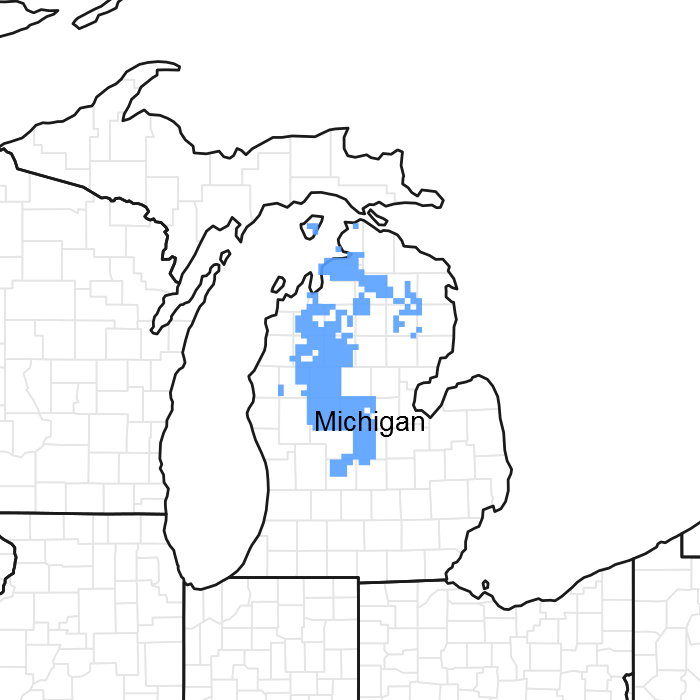
Natural Resources
Conservation Service
Ecological site F094AA003MI
Snowy Loamy Depression
Last updated: 9/10/2024
Accessed: 12/21/2025
General information
Provisional. A provisional ecological site description has undergone quality control and quality assurance review. It contains a working state and transition model and enough information to identify the ecological site.

Figure 1. Mapped extent
Areas shown in blue indicate the maximum mapped extent of this ecological site. Other ecological sites likely occur within the highlighted areas. It is also possible for this ecological site to occur outside of highlighted areas if detailed soil survey has not been completed or recently updated.
MLRA notes
Major Land Resource Area (MLRA): 094A–Northern Michigan Sandy Highlands
This area is dominated by outwash plains and moraines. The terrain can be steep on the moraines and flat in the areas of outwash. Elevation ranges from 177 to 520 m (580 to 1705 ft). Local topographic relief averages 14 m and ranges up to 188 m (45 to 615 ft). This area is covered entirely by drift. Bedrock consisting of Devonian limestone and dolomite with interbedded shale, chert, and anhydrite stringers is at various depths below the surface because of the curvature of the Michigan basin. However, bedrock exposures completely absent, as the depth of glacial drift ranges from 60 to 300 m (200-1000 ft). The Au Sable, Manistee, Au Gres, and Pine Rivers are the major streams draining this MLRA, in both the Lake Michigan and Lake Huron watersheds. The Muskegon River has its headwaters in this area.
About 70 percent of this area is forested, and about 15 percent is cropland or hayland. About one-third of the area is in small, privately owned holdings, and another one-third consists of national and State forests. The forests are used mainly for timber production and recreation. Dairy and beef operations are very important enterprises in the area. Forage and feed grains for dairy cattle and other livestock are the principal crops. Wheat, oats, corn, potatoes, and hay also are grown in the area. The Huron and Manistee National Forests, Hartwick Pines State Park, Camp Grayling (Department of Defense), Pigeon River Country State Forest are among the most notable conservation lands in the area. Reaches of the Au Sable and Pine Rivers are National Wild and Scenic Rivers.
Summary of existing land use:
Upland Forest (58%)
Hardwood (41%)
Conifer (15%)
Swamps and Marshes (14%)
Developed (11%)
Agricultural (10%)
Grassland (5%)
Classification relationships
According to the USFS (Bailey) system of ecoregions, the site is located mostly within 212Hc (Interlobate End and Ground Moraines), 212He (Kalkaska Sandy Moraines), and 212Hi (Wolverine Moraines) subsections. According to the EPA (Omernik) system of ecoregions, the site is located in western 50ac (Onaway Moraines), western 50ad (Vanderbilt Moraines), and 50af (Cadillac Hummocky Moraines) level IV ecoregions. This site concept is outside the range of the USFS Ecological Land Type classification and the Kotar system.
Ecological site concept
The central concept of Snowy Loamy Depression is lowlands with watertables 25 to 50 cm deep (somewhat poorly drained). loamy drift (till or lake plains) with soil textures loamy to clayey (upper 50 cm <70% sand). Site is in the heavy annual snowfall belt, mostly west of Houghton Lake where fire was rare. Vegetation trending towards mesophytic forest with a rich herb understory and a low fire frequency.
Associated sites
| F094AA002MI |
Snowy Loamy Till |
|---|---|
| F094AA004MI |
Snowy Wet Loamy Depression |
Similar sites
| F094AB016MI |
Loamy Depression |
|---|
Table 1. Dominant plant species
| Tree |
(1) Acer saccharum |
|---|---|
| Shrub |
Not specified |
| Herbaceous |
(1) Mitella diphylla |
Click on box and path labels to scroll to the respective text.